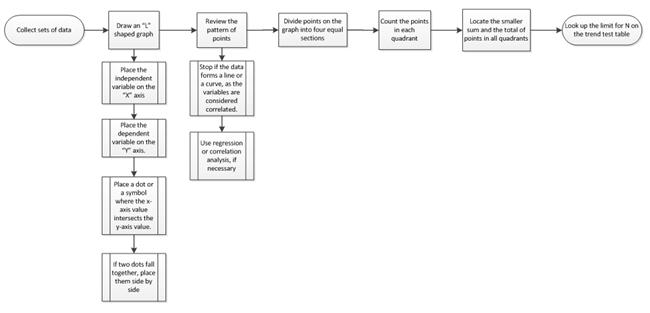Need to Study Module Versus Scatter Plot Review
A Scatter Diagram provides human relationship between two variables, and provides a visual correlation coefficient.
Why You lot Would Use Scatter Analysis and Scatter Plots
A Scatter Analysis is used when you need to compare 2 data sets against each other to encounter if there is a relationship. Scatter plots are a way of visualizing the relationship; by plotting the data points you go a scattering of points on a graph. The analysis comes in when trying to discern what kind of design – if any – is present. And what that pattern means.
It is this kind of analysis we are talking about when we are trying to get at the root cause of an issue.
Scatter Diagrams are used to show the "cause-and-effect" relationship between two kinds of data, and to provide more useful information about a production process.
Specific instances of when to utilise scatter diagrams:
- Pairs of numerical figures are present
- Dependent variables have multiple values for each figure associated with the independent variable
- Defining if in that location is a relationship between 2 variables
What Kind of Data Should You Use on Scatter Analysis?
Besprinkle analysis by and large makes utilise of continuous data. (See notes on the different information types here.)
Discrete data is best at pass/ fail measurements. Continuous data lets y'all measure things deeply on an space set and is by and large used in scatter analysis.
You could use discrete data on one centrality of a scatter plot and continuous data on the other axis. For the discrete data, you'd accept to put it into some kind of quantified band – like say ane-10 on a customer satisfaction score.
I suppose yous also *could* put discrete data that comes out like pass/fail as one of two bands, but information technology would really depend on the information if y'all got whatsoever useful information out of it.
Best bet is continuous information.
If yous are looking for a way to do graphical analysis on discrete data, you might attempt attribute charts.
Scatter Plot Videos
Scatter Plots and Correlation
Scatter plots only bear witness correlation. They exercise not bear witness causation. The instance often used is shark attacks and water ice cream sales. There may be a correlation between the ii, merely ice cream does not crusade shark attacks — the heat of the twenty-four hours does. In other words, more people are in the h2o on hot days equaling more shark attacks, and more people buy ice cream on hot days
How to Make a Scatter Diagram:

- Collect sets of data where a relationship is present.
- Draw a graph in the shape of an "50," and make the scale even multiples (i.e., ten, 20).
- Place the independent variable on the horizontal (10) axis.
- Place the dependent variable on the vertical (Y) axis.
- Identify a dot or a symbol where the ten-axis value intersects the y-centrality value.
- If two dots fall together, place them side by side, so they are touching, and both are visible.
- Review the blueprint of points to make up one's mind if a relationship is present:
- Stop if the information forms a line or a curve, as the variables are considered correlated.
- Use regression or correlation analysis, if necessary. If regression or correlation analysis are not needed, complete steps four through seven below.
- Divide points on the graph into four equal sections. If 10 points are present on the graph:
- Count Ten/2 points from top to bottom and describe a horizontal line.
- Count X/two points from left to right and draw a vertical line.
- If the number of points is odd, draw a line through the middle betoken.
- Count the points in each quadrant.
NOTE: Do not count points on a line.
- Locate the smaller sum and the total of points in all quadrants, and add together the diagonally contrary quadrants:
A = points in upper left + points in lower correct
B = points in upper right + points in lower left
Q = the smaller of A and B
N = A + B
- Look upwards the limit for N on the trend examination tabular array:
- If Q is less than the limit, the two variables are related.
- If Q is greater than or equal to the limit, the blueprint may accept originated from random chance.
Source: https://sixsigmastudyguide.com/scatter-analysis-regression/
0 Response to "Need to Study Module Versus Scatter Plot Review"
Post a Comment